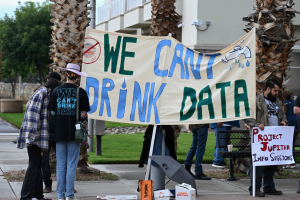
Opposition Mounts Over Project Jupiter Data-Center in New Mexico
Some New Mexico residents filed lawsuits over the massive Project Jupiter data-center proposal near the Texas border. They argue the plan will violate the Energy Transition Act, and that Doña Ana County approved the deal without a complete application.
Lawsuits Cite Incomplete Application and State-Law Violations
The lawsuits argue that the county violated state law by approving revenue bonds despite incomplete documentation. One resident commented, “A promise is meaningless without real, written commitments and hard data.”
Another source described the county vote: “The Board of County Commissioners is violating that trust in its rush to approve the $165 billion Project Jupiter data-center Industrial Revenue Bond.”
$165 Billion Industrial Revenue Bonds Approved
On Sept. 19, 2025 the commission voted to approve up to $165 billion in industrial revenue bonds for Project Jupiter.
One local official said, “The Board is looking forward to discussing how an investment of this magnitude could expand our economic footprint and significantly improve the quality of life for all who call Doña Ana County home.”
Project Jupiter Plan, Power and Location Highlights
The project, led by STACK Infrastructure and BorderPlex Digital Assets, would locate in unincorporated Doña Ana County, near the U.S.–Mexico border.It proposes four large data-centers, a dedicated on-site microgrid and battery storage system.
A spokesman for BorderPlex said, “Growth infrastructure isn’t just about powering tomorrow’s technology – it’s about putting communities first.”
Dedicated Power, But Critics Flag Fossil Fuel Concern
Project Jupiter plans to generate its own power via a microgrid. Its announcement states the microgrid will “meet its own energy needs … ensuring there is no impact on local ratepayers.”
However, opponents warn the plan includes a natural-gas power plant or microgrid using fossil fuel, not just renewables. One local organizer said, “Closed-loop systems still require additional water supplies … and natural gas power plants … consume massive amounts of water.”
A former state regulator said of similar microgrids, “It basically gives microgrids a get-out-of-jail-free card on any carbon controls.”
Water, Incentives and Environmental Risk
Residents pressed the county for details on water draw and usage. The county presentation projected a draw comparable to “50 houses” of water per day.
A critic wrote: “The public deserves transparent, thorough, and independent vetting of the proposed project.”
Concern surrounds the regime of tax breaks and incentives. The IRB shields the developer from property taxes and general receipts taxes while requiring binding commitments.
Economic Promise and Community Commitment
Project Jupiter’s backers highlight job creation and infrastructure investment. The release says the project “would bring up to $165 billion in private investment … more than 2,500 construction jobs … at least 750 permanent full-time roles with average salaries between $75,000 and $100,000.”
Officials promise water-and-sewer infrastructure investment. The developers pledged “$10 million … to provide to the City of Sunland Park through a metrics-driven grant program aimed at improving water quality in the community.”
Timeline, Next Steps and Legal Challenges
The project remains contingent on final approvals of permits and incentives.
Meanwhile, lawsuits challenge the legality of approval and environmental compliance. One lawsuit argued the approval process lacked adequate disclosure.
At a public hearing, opponents wore “Stop Project Jupiter” shirts and demanded a delay for proper review. “With that level of financial investment for New Mexico, we should be able to prove the benefit to the community. We shouldn’t have to be rushing to a decision,” said Sunland Park’s city manager.
SOURCE: NM Borderplex—Rewritten by Oklahoma Energy Today for clarity

